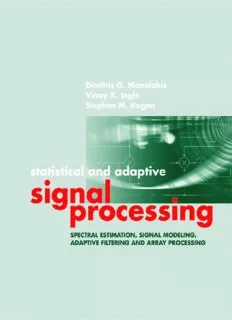Table Of ContentStatistical
and Adaptive
Signal Processing
Recent Titles in the Artech House Signal Processing Library
Computer Speech Technology, Robert D. Rodman
Digital Signal Processing and Statistical Classification, George J. Miao and
Mark A. Clements
Handbook of Neural Networks for Speech Processing,
Shigeru Katagiri, editor
Hilbert Transforms in Signal Processing, Stefan L. Hahn
Phase and Phase-Difference Modulation in Digital Communications,
Yuri Okunev
Signal Processing Fundamentals and Applications for Communications and Sensing
Systems, John Minkoff
Signals, Oscillations, and Waves: A Modern Approach, David Vakman
Statistical Signal Characterization, Herbert L. Hirsch
Statistical Signal Characterization Algorithms and Analysis Programs,Herbert L. Hirsch
Voice Recognition,Richard L. Klevans and Robert D. Rodman
For further information on these and other Artech House titles, including previously
considered out-of-print books now available through our In-Print-Forever®(IPF®)
program, contact:
Artech House Artech House
685 Canton Street 46 Gillingham Street
Norwood, MA 02062 London SW1V 1AH UK
Phone: 781-769-9750 Phone: +44 (0)20 7596-8750
Fax: 781-769-6334 Fax: +44 (0)20 7630-0166
e-mail: artech@artechhouse.com e-mail: artech-uk@artechhouse.com
Find us on the World Wide Web at: www.artechhouse.com
Statistical
and Adaptive
Signal Processing
Spectral Estimation, Signal Modeling, Adaptive
Filtering, and Array Processing
Dimitris G. Manolakis
Massachusetts Institute of Technology
Lincoln Laboratory
Vinay K. Ingle
Northeastern University
Stephen M. Kogon
Massachusetts Institute of Technology
Lincoln Laboratory
artechhouse.com
Library of Congress Cataloging-in-Publication Data
A catalog record for this book is available from the U.S. Library of Congress.
British Library Cataloguing in Publication Data
A catalogue record for this book is available from the British Library.
This is a reissue of a McGraw-Hill book.
Cover design by Igor Valdman
© 2005 ARTECH HOUSE, INC.
685 Canton Street
Norwood, MA 02062
All rights reserved. Printed and bound in the United States of America. No part of this
book may be reproduced or utilized in any form or by any means, electronic or
mechanical, including photocopying, recording, or by any information storage and
retrieval system, without permission in writing from the publisher.
All terms mentioned in this book that are known to be trademarks or service marks
have been appropriately capitalized. Artech House cannot attest to the accuracy of this
information. Use of a term in this book should not be regarded as affecting the validity of
any trademark or service mark.
International Standard Book Number: 1-58053-610-7
10 9 8 7 6 5 4 3 2 1
To my beloved wife, Anna, and to the loving memory of my father, Gregory.
DGM
To my beloved wife, Usha, and adoring daughters, Natasha and Trupti.
VKI
To my wife and best friend, Lorna, and my children, Gabrielle and Matthias.
SMK
ABOUT THE AUTHORS
DIMITRISG.MANOLAKIS,anativeofGreece,receivedhiseducation(B.S.inphysics
andPh.D.inelectricalengineering)fromtheUniversityofAthens,Greece.Heiscurrently
amemberofthetechnicalstaffatMITLincolnLaboratory,inLexington,Massachusetts.
Previously,hewasaPrincipalMember,ResearchStaff,atRiversideResearchInstitute.Dr.
ManolakishastaughtattheUniversityofAthens,NortheasternUniversity,BostonCollege,
and Worcester Polytechnic Institute; and he is coauthor of the textbook Digital Signal
Processing: Principles, Algorithms, and Applications (Prentice-Hall, 1996, 3d ed.). His
research experience and interests include the areas of digital signal processing, adaptive
filtering, array processing, pattern recognition, and radar systems.
VINAY K. INGLE is Associate Professor of Electrical and Computer Engineering at
NortheasternUniversity.HereceivedhisPh.D.ineletricalandcomputerengineeringfrom
RensselaerPolytechnicInstitutein1981.Hehasbroadresearchexperienceandhastaught
courses on topics including signal and image processing, stochastic processes, and
estimationtheory.ProfessorIngleiscoauthorofthetextbooksDSPLaboratoryUsingthe
ADSP-2101 Microprocessor (Prentice-Hall, 1991) and DSP Using Matlab (PWS
Publishing Co., Boston, 1996).
STEPHENM.KOGONreceivedthePh.D.degreeinelectricalengineeringfromGeorgia
Institute of Technology. He is currently a member of the technical staff at MIT Lincoln
LaboratoryinLexington,Massachusetts.Previously,hehasbeenassociatedwithRaytheon
Co.,BostonCollege,andGeorgiaTechResearchInstitute.Hisresearchinterestsareinthe
areasofadaptiveprocessing,arraysignalprocessing,radar,andstatisticalsignalmodeling.
e56toc.qxd 3/16/05 11:56 AM Page x
CONTENTS
Preface xvii 2.3 Discrete-Time Systems 47
2.3.1 Analysis of Linear,
1 Introduction 1 Time-Invariant Systems / 2.3.2
Response to Periodic Inputs / 2.3.3
1.1 Random Signals 1 Correlation Analysis and Spectral
Density
1.2 Spectral Estimation 8
2.4 Minimum-Phase and
1.3 Signal Modeling 11
System Invertibility 54
1.3.1Rational orPole-Zero
2.4.1 System Invertibility and
Models / 1.3.2 Fractional
Minimum-Phase Systems /
Pole-Zero Models and
2.4.2 All-Pass Systems / 2.4.3
Fractal Models
Minimum-Phase and All-Pass
1.4 Adaptive Filtering 16 Decomposition / 2.4.4 Spectral
1.4.1 Applications of Adaptive Factorization
Filters / 1.4.2 Features of 2.5 Lattice Filter Realizations 64
Adaptive Filters
2.5.1 All-Zero Lattice Structures /
1.5 Array Processing 25 2.5.2 All-Pole Lattice Structures
1.5.1 Spatial Filtering or 2.6 Summary 70
Beamforming/1.5.2 Adaptive
Problems 70
Interference Mitigation in
Radar Systems/1.5.3 Adaptive
3 Random Variables,Vectors,
Sidelobe Canceler
and Sequences 75
1.6 Organization of the Book 29
3.1 Random Variables 75
2 Fundamentals of Discrete-
Time Signal Processing 33 3.1.1 Distribution and Density
Functions / 3.1.2 Statistical
Averages / 3.1.3 Some Useful
2.1 Discrete-Time Signals 33
Random Variables
2.1.1 Continuous-Time,Discrete-
3.2 Random Vectors 83
Time,and Digital Signals /
2.1.2 Mathematical Description of 3.2.1 Definitions and Second-Order
Signals / 2.1.3 Real-World Signals Moments / 3.2.2 Linear
Transformations of Random
2.2 Transform-Domain
Vectors / 3.2.3 Normal Random
Representation of
Vectors / 3.2.4 Sums of Independent
Deterministic Signals 37
Random Variables
2.2.1 Fourier Transforms and
3.3 Discrete-Time Stochastic
Fourier Series / 2.2.2 Sampling
Processes 97
of Continuous-Time Signals /
2.2.3 The Discrete Fourier 3.3.1 Description Using
Transform / 2.2.4 The Probability Functions / 3.3.2
z-Transform / 2.2.5 Representation Second-Order Statistical
of Narrowband Signals Description / 3.3.3 Stationarity /
x
Description:Signal processing is an essential topic for all practicing and aspiring electrical engineers to understand no matter what specific area they are involved in. Originally published by McGraw-Hill* and now reissued by Artech House, this definitive volume offers a unified, comprehensive and practical tr

